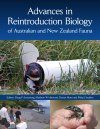By: Doug P Armstrong(Editor), Matthew W Hayward(Editor), Dorian Moro(Editor), Philip J Seddon(Editor)
303 pages, b/w photos, b/w illustrations, b/w maps, tables
![Advances in Reintroduction Biology of Australian and New Zealand Fauna Advances in Reintroduction Biology of Australian and New Zealand Fauna]()
Click to have a closer look
About this book
Contents
Customer reviews
Biography
Related titles
About this book
The publication of Reintroduction Biology of Australian and New Zealand Fauna nearly 20 years ago introduced the new science of 'reintroduction biology'. Since then, there have been vast changes in our understanding of the process of reintroductions and other conservation-driven translocations, and corresponding changes in regulatory frameworks governing translocations.
Advances in Reintroduction Biology of Australian and New Zealand Fauna is a timely review of our understanding of translocation from an Australasian perspective, ensuring translocation becomes an increasingly effective conservation management strategy in the future. Written by experts, including reintroduction practitioners, researchers and policy makers, the book includes extensive practical advice and example case studies, identifies emerging themes and suggests future directions.
Topics include: key questions in reintroduction biology; population establishment; prey naivety; disease management; dispersal; the roles of trials and experiments; modelling projections; assisted colonisation; population interchange; genetic diversity; disease management; metapopulation dynamics; reintroduced species as ecological engineers; the contributions of sanctuary networks and zoos; and extensive insights from reintroduction programs.
Advances in Reintroduction Biology of Australian and New Zealand Fauna is aimed at conservation practitioners and researchers, as well as conservation management agencies and NGOs. Although it is based on Australasian examples, it will be of interest globally due to synergies with reintroduction programs throughout the world.
Contents
1. Introduction: the development of reintroduction biology in New Zealand and Australia
2. Release strategies for fauna reintroductions: theory and tests
3. Structured decision making for designing complex release strategies
4. The influence of predators and prey naivety on reintroduction success: current and future directions
5. Disease-risk management in reintroduction
6. Considering dispersal in reintroduction and restoration planning
7. The roles of trials and experiments in fauna reintroduction programmes
8. Advances in modelling projections for reintroduced populations
9. Proactive conservation or planned invasion? Past, current and future use of assisted colonisation
10. Conserving and enhancing genetic diversity in translocation programmes
11. Metapopulation management of an extreme disease scenario
12. Using reintroduction to compensate for isolation in fragmented landscapes
13. Policy implications of ecosystem engineering for multiple ecosystem benefits
14. The impact of private of sanctuary networks on reintroduction programmes
15. Advances in the contribution of zoos to reintroduction programmes
16. Forty years of fauna translocations in Western Australia: lessons learned
17. Underwater, out of sight: lessons from threatened freshwater fish translocations in Australia
18. Practical guidelines for planning and implementing fauna translocations
19. Evolution of the translocation approval process in Australia and New Zealand
20. Future directions in reintroduction biology of Australian and New Zealand fauna
Index
Customer Reviews
Biography
Doug P. Armstrong is Professor of Conservation Biology at Massey University, New Zealand, and is the Oceania Chair of the IUCN Reintroduction Specialist Group. He has led a research program focused on reintroduction biology for 22 years, and has been involved in numerous New Zealand reintroduction projects in leading, participant or advisory roles. He has authored over 40 reintroduction-related papers in Australasian and international journals, and was co-editor of the 2012 book Reintroduction Biology: Integrating Science and Management.
Matthew W. Hayward is an Australian wildlife manager now based at Bangor University, Wales. He has been involved in reintroduction projects in three continents, including researching the impacts of the reintroduction of large predators to Addo Elephant National Park in South Africa; studying the ecology of reintroduced European bison in Poland’s Bialowieza Primeval Forest; planning, implementing and monitoring reintroductions for the Australian Wildlife Conservancy in south-eastern Australia; and now to supervising students involved in the reintroduction of Eurasian beavers to Wales. He is a member of the IUCN Species Survival Commission Reintroduction Specialist Group and was co-editor of the 2009 book Reintroduction of Top-Order Predators.
Dorian Moro is a lead ecologist with Chevron Australia, and holds an Adjunct Associate Professor position with Murdoch University, Australia. He is a member of the IUCN Species Survival Commission Reintroduction Specialist Group and has authored papers relating to mammal conservation and translocation to islands and to areas with exotic predator control, translocations and wildlife disease, and population genetics as these relate to island systems. He works closely with industry and wildlife management agencies to provide strategic technical advice to advocate the use of evidence-based science to support the conservation assets of marine and terrestrial reserves.
Philip J. Seddon is a Professor of Zoology and Director of the Postgraduate Wildlife Management Programme at the University of Otago, New Zealand. He has been the Bird Section Chair of the IUCN Reintroduction Specialist Group since 1998, and has been involved in bird, mammal and herptile reintroduction project planning, implementation and review in New Zealand, Australia, South Africa, Saudi Arabia, the United Arab Emirates, Canada and Japan. He has authored over 40 reintroduction-related papers and book chapters, and was co-editor of the 2012 book Reintroduction Biology: Integrating Science and Management.
By: Doug P Armstrong(Editor), Matthew W Hayward(Editor), Dorian Moro(Editor), Philip J Seddon(Editor)
303 pages, b/w photos, b/w illustrations, b/w maps, tables


































